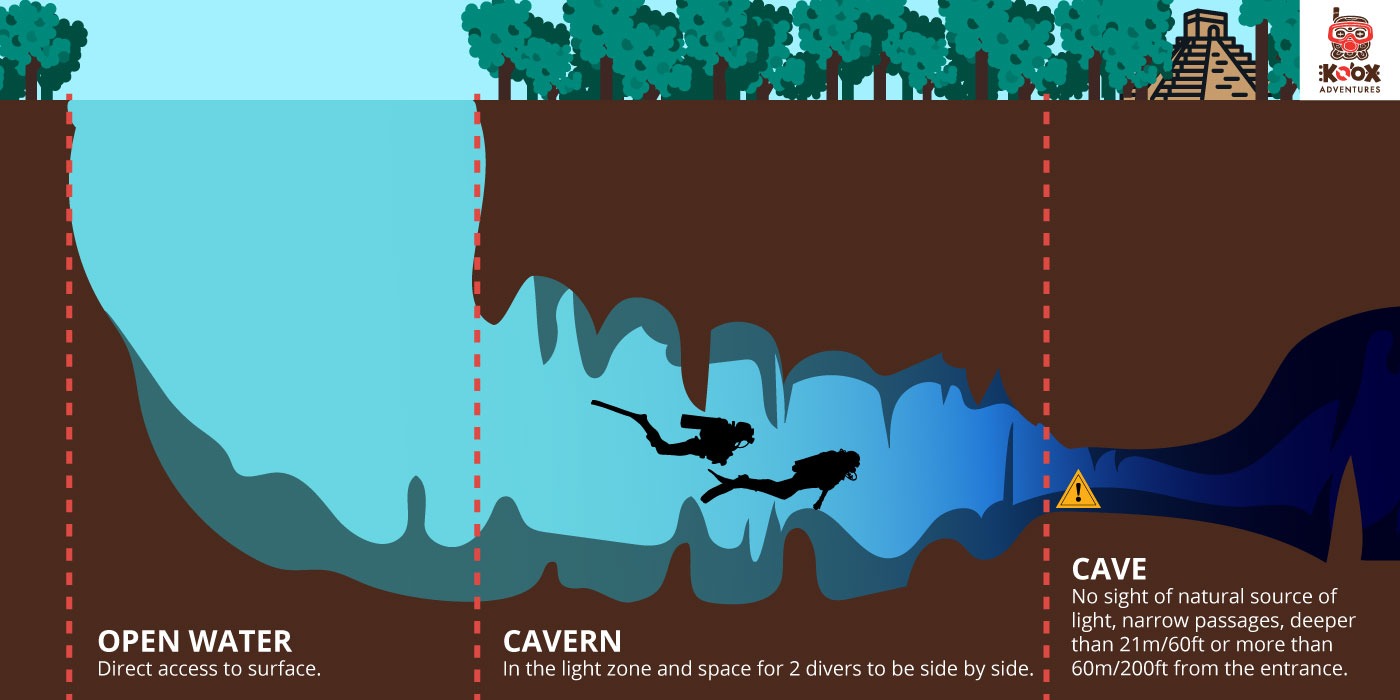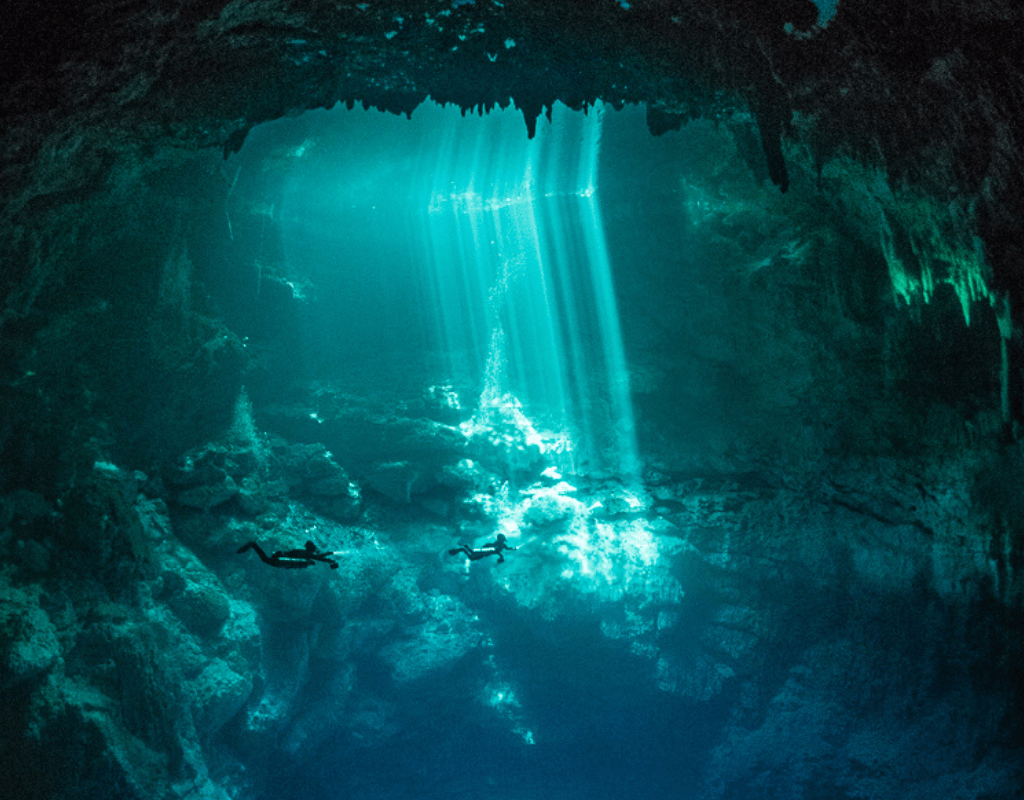Are you curious about scuba diving in cenotes near Tulum and Playa del Carmen? In this post, we’d discuss all you need to know before you try: what is the difference between open water, cavern, and cave from a scuba diving perspective. What certification and equipment are required to scuba dive in cenotes and what safety diving rules apply. Also, of course, which are the best cenotes to dive in based on your experience and comfort level, so keep reading!
Differences Between Open water, Cavern and Cave diving
Cenotes – can also be Open Water:
There are some cenotes that offer an open water environment and shallow depth – like a natural swimming pool, which means you can even try scuba diving for the first time in a cenote. In these particular cenotes (Casa Cenote for example) we normally do the discovery dives and training dives for the open water courses in Tulum and Playa del Carmen.
Cavern vs Cave – what’s the difference:

The definition of a cavern is the entrance area that remains within the ambient light zone of a cave always close to an open water area, and by close, we mean no more than 60m/200ft distance and no deeper than 21m/60ft. This allows that in case of emergency you can quickly swim out of the overhead environment by just following the natural light. If at any given moment of the dive you can’t see the natural source of light, it means you are in a cave, and things just got to a different level of training, planning, and risk management, so unless you are a full cave diver you shouldn’t be there.
Cavern guided tours:
This is what we do in some Cenotes around the Yucatan peninsula, and most of these Cenotes have already a set “circuit” that goes around the most interesting areas so you can admire all the different formations without leaving the “cavern area”, this means that sometimes the line that you are going to follow can be pretty long, but there will be always an exit nearby, either a source of light or an open water area where you can surface if needed. Also, a lot of people are worried about small spaces and restrictions but in these tours, you are never going through tight spaces and there will be always plenty of space, you will be surprised about the size of these amazing underwater rivers!
So how dangerous is cenote diving?
To answer this question we must be clear on what kind of scuba diving you’d be doing, most people think that scuba diving in cenotes is dangerous and should not be done unless you are fully trained to do so – yes, this is true for cave diving, which is considered the most dangerous extreme sport in the world. But if just want to do guided cenote diving, you only need to be an open water certified diver, and then it is perfectly safe to scuba dive in the cenotes / caverns following your cenote dive guide and the safety rules.
What Rules Apply to Guided Cenote Diving?
When diving into an overhead environment special rules apply, and it’s very important that we respect these rules:
General rules:

You are not allowed to wear gloves, snorkel, or a knife in the cenotes It is also forbidden to touch the formations or sediments, as the damage to them is irreversible! All your equipment should be streamlined and nothing should be dangling.
Ambient light zone:

Аs we explained before, you must always be within sight of a natural source of light and within 60m distance from an open water area.
Your guide:
Your guide must be certified as a full cave diver on top of the Divemaster/instructor rating and must be in full cave gear setup in order to lead this dive (double tanks, either Backmount or Sidemount) bringing backup lights as well. The guide will always be first, leading the group, and never leave the line (normally thick and orange).
Amount of divers:

There is a maximum ratio of 4 divers per guide, everyone must dive in single line formation behind the guide and not too far away from each other (we recommend 1-2m/3-6ft max distance from each other).
Gas management and time limit:

We follow the famous “rule of thirds”, which means we use 1/3 of the tank supply to go in, 1/3 to go back and the last 1/3 we reserve just in case someone requires air. Your guide will quite often ask you to signal how much gas you have left in your tank (this is important as in most cenotes we don’t turn the dive and swim all the way back, we might be closer to the exit, already on the way, as we are heading towards the end of the circuit).
Restrictions – the line of the circuit:

The circuits that we are following are set without restrictions, this means that at all times during your dives you are not going to encounter narrow passages where two divers won’t fit in comfortably.
Buoyancy control:

Good buoyancy control and trim are essential to be able to enjoy diving in cenotes as you don’t want to end up on the ceiling of the cavern thus hurting yourself and damaging the formations. The kicking techniques that we recommend are the frogkick or a modified flutter kick to avoid lifting sediments and damaging the bottom. Some cenotes require more advanced diving skills than others, hence we only take experienced divers with proven buoyancy control. The better diver you are, the better and more interesting cenotes you’d get to scuba dive in! )
Respect the limits:

Your guide should never ask you to leave the line of the circuit, and if you see the signal warning you that you are leaving the cavern zone to enter the cave, you should not proceed. It is very important as well to respect your own limits, remember that at any given moment if you are not comfortable you can call the dive and your guide will lead you outside the cavern immediately, no questions asked (this is what we call the golden rule).
What Certification and How Much Experience is Needed to Scuba Dive in the Cenotes?

There are many cenotes to choose between Playa del Carmen and Tulum, some are deep, some are a bit darker than others, some offer plenty of formations, and some even have a hydrogen gas cloud at the bottom! So taking this into account, the requirements also change, but you can do guided cenote dives as an Open Water Diver already.
Here is a list of certification requirements and experience needed to dive in the most popular cenotes near Tulum & Playa del Carmen:
Casa Cenote: no requirements – open-air cenote – suitable for Discover Scuba Dives & Training sessions
Dos Ojos Cenote: Open Water Diver or equivalent certification required
Carwash Cenote: Open Water Diver or equivalent certification required
Calavera Cenote: Open Water Diver or equivalent certification required
Chikin Ha Cenote: Open Water Diver or equivalent certification required
Tajma Ha Cenote: Open Water Diver or equivalent certification required
Jardin del Eden Cenote: Open Water Diver or equivalent certification required
Kin Ha Cenote: Open Water Diver or equivalent certification required
The Pit: Advanced Open Water Diver or equivalent certification required
Angelita Cenote: Advanced Open Water Diver or equivalent certification required
Tak be Ha Cenote: Advanced Open Water Diver or Equivalent (needs staff approval)
Tak Be Luum Cenote: Advanced Open Water Diver or Equivalent (needs staff approval)
DreamGate Cenote: Advanced Open Water Diver or Equivalent (needs staff approval)
Cenote Maravilla: Advanced Open Water Diver or Equivalent (needs staff approval)
Cenote Zapote: Advanced Open Water Diver or Equivalent (needs staff approval)
Best Cenotes to Scuba Dive in Mexico
Now you know all about cenote diving, now time to choose which cenote to go diving in. It really depends on what you would like to experience.
Fancy some under the roots of the mangroves diving? Or maybe you’d like to admire the beams of light trespassing all the way from the jungle to the bottom of the cenote at 30m/100ft?
Maybe you’d want to experience going through a thick layer of a hydrogen gas cloud or even playing with the mix of fresh and saltwater?
Or just admire the numerous formations in shallow water and wonder how old they are actually? (hint: they are more than thousands of years old!)
There’s a special cenote for everyone, each one has its own different atmosphere and ambiance.
Check the video list of Top 9 cenotes for Scuba divers from our friend Jordan, from Expedition Drenched filmed while diving with us:
If you still have some questions or doubts remember that you can always send us an email, a WhatsApp message, or simply chat with us directly from our website. We will recommend and organize the best places that will always fit your experience and comfort level so you can safely get the best cenote diving experience. So what are you waiting for? Ko’ox!






